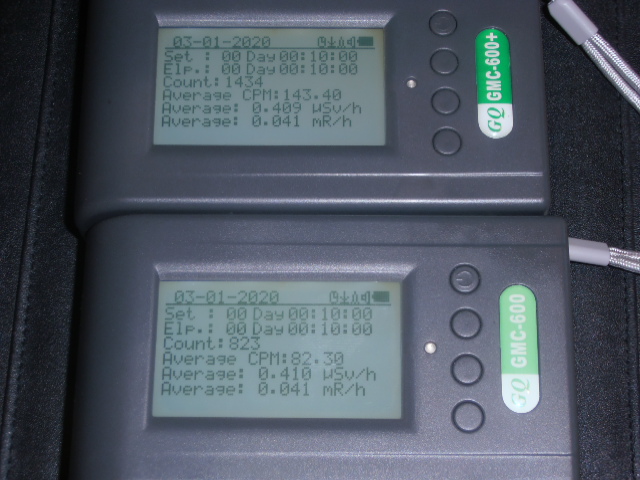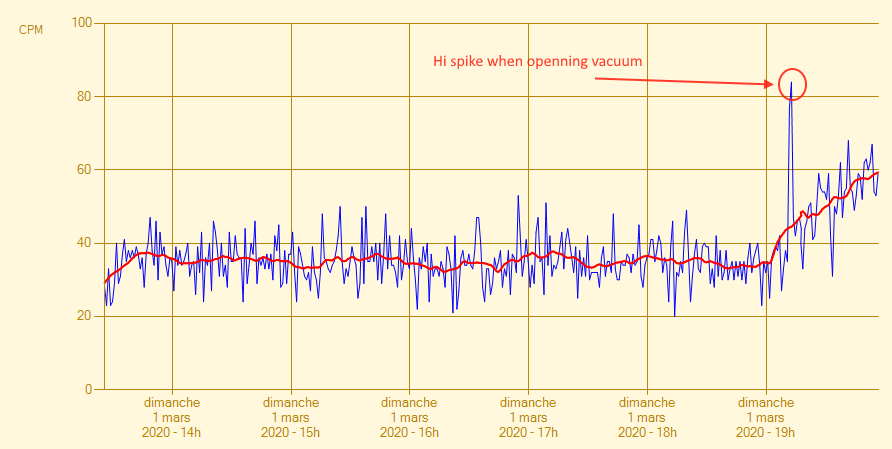| T O P I C R E V I E W |
| Stargazer 40 |
Posted - 03/01/2020 : 08:27:23
@bigfatdaddy in an earlier post was trying to measure Radon radioactivity. I had always thought that the 4.0 pCi/L EPA limit standard was beneath the sensitivity of the 600 series alpha capable meters - until I ran across this video in Youtube from 2014 that shows a comparison of a Radalert 7317 meter (pretty sure) and a Series 3 Pro Radon meter.
https://www.bing.com/videos/search?q=can+an+alpha+pancake+tube+detect+radon+gas&view=detail&mid=55399EAC3554C7B69F8B55399EAC3554C7B69F8B&FORM=VIRE
As in a chemistry class long ago, to measure some things we had to concentrate the weak signal by increasing the sensitivity of the meter or increasing the weak signal from the source. The video above shows the effect of Radon attaching itself to dust particles that wind up embedded in an air purification filter. The meters response is increased by a factor of roughly 60 through the concentration of radioactive dust particles on the filter surface. This brings the measured alphas way above background and gives us a chance to compare with the response of the dedicated Radon meter.
I decided to use my furnace filter that was due for a change. Using both the 600 and 600+ meters I took a 10 minute Timed Count. The 7317 GM tube uses a conversion of 350 CPM/uSv/hr. To get a similar alpha response from the 600's SBT-11A GM tube I used 200 CPM/uSv/hr.
Here is a picture of the two meters and background with those conversions and my Series 3 Pro Radon meter measuring 2.1 pCi/L:
Image Insert:

146234 bytes
My Radon meter reading is below the 4.0 pCi/L EPA limit standard. My 600/+ meters show what for me is a background amount of around .2 uSv/hr.
Here is a picture of the two 600/+ meters after 10 minute Timed Count on the filtered debris side of the furnace filter I just changed out:
Image Insert:

144667 bytes
The 600/+ meters show a doubling of the amount of dosage to .410 uSv/hr. I think this shows I have some measurable Radon, which is normal.
If we go back to the video we see a measure of 6.8 pCi/L on the Radon meter and about 2900 CPM on the 7317 meter placed on the filter surface, which correlates to 8.26 uSv/h. We can't simply compare the two as the filters are entirely different. But we should be able to generalize and say that by employing a fine air filter to concentrate radioactive dust particles, we can get a feel for the presence of Radon gas and just maybe work towards a calibration. Hopefully more to come.
|
| 5 L A T E S T R E P L I E S (Newest First) |
| halo jones |
Posted - 05/28/2020 : 05:23:35
I've been detecting radon leakage indirectly from radium watches etc using GMC-600+. I place the source into a small plastic box for 10 hours. Then I carefully open the box, remove the source, and sweep the interior of the box with piece of toilet paper (yeah really scientific material!). :) Highest readings so far have been around 5.7 uSv/h from old temperature gauge from a tank (or aircraft). I could take photos if someone's interested. Not any kind of plastic box will work, I guess the material must attract the particles to attach onto the walls of the container, or something... (?) |
| Stargazer 40 |
Posted - 03/08/2020 : 04:58:10
Thanks for that post. You might take a look at Reply #1 of my calibration thread where the SBT-11/A looks to be much less sensitive than the 7317 for beta and gamma, but compared to its beta and gamma response more sensitive for alpha. I get the best match for the former at 82CPM/uSv/hr and 200CPM/uSv/hr for alpha.
https://www.gqelectronicsllc.com/forum/topic.asp?TOPIC_ID=7699
The 7317 is the standard here and I used its normal 350 CPM across sources.
I have found that the GM tubes have different responses not only for different radiation types and energies, but also for source geometry (point versus background). Certainly for alpha the mica window orientation during measurement is critical.
The background radiation measurement comparison does show lower amount. However that measure was not related to furnace filter dust accumulation, just setting meters out for a timed count. My calibration efforts are focused on event levels and using the meters as sample meters and not so much as survey meters (background). |
| Searinox |
Posted - 03/06/2020 : 03:00:32
There is an experiment trending among geiger/radiation enthusiasts on YouTube involving covering the nozzle of a vacuum cleaner with tissues or some kind of filter material and letting it run in place for about 30 minutes, then checking the filter with a counter for Radon-222 progeny.
These isotopes are very short lived and after about half hour the radiation reading halves, and 3 hours later there is only slightly above background radiation as the -210 atomic mass range isotopes decay over the course of a few days. Using a GMC-600 non-plus version, I performed the experiment and got around 0.8 uSv/h immediately after turning off the vacuum.
Bear in mind that it is not yet clear how much radiation corresponds to how much Radon though from what I've seen from other people's measurements it seems like around 10 uSv/h or more is a sensible point at which to start getting concerned. One person who knew they had a Radon problem did the test and got about 90 uSv/h.
Myself, I live at the 5th floor of an apartment building so I didn't expect much to begin with. A friend at work was also curious so I borrowed him my counter and he performed the experiment getting 0.4-0.5 uSv/h. He also lives at the 5th floor. In my experience having an alpha window was very important because I then tried the GMC-320+ on the tissues while the dust was still "fresh" and only got up to about 0.3 uSv/h.
Your non-plus GMC-600 is indicating less radiation. From personal experience I'd recommend changing the conversion rate of the SBT-11 down from 300 closer to 250 CPM/uSv. Although the manual of the SBT-11 indicates a value of 316 CPM/uSv that often ends up not being the case and is overstated, not sure of the tubes' age has anything to do with it since these are old Soviet tubes no longer in production and I was only able to get a reliable 278 CPM/uSv sensitivity after substantial overvolting. |
| Stargazer 40 |
Posted - 03/01/2020 : 11:38:16
Really cool. I just mentioned that the Radon was attaching itself to the dust particles. In actuality many of the daughter products last only a few seconds to tens of minutes and they are also what we're getting alphas from (and some betas) besides the primary Radon decay.
|
| Damien68 |
Posted - 03/01/2020 : 11:05:45
@Stargazer40: Nice video,
it gave me the idea to test the bag of my vacuum cleaner,
I just speedly tried with an SBM-20 tube which is already connected on my dosimeter. which therefore does not detect alpha radiation. I have the following mesures:
Image Insert:

44728 bytes
we can clearly see the average CPM which increases. certainly with the disintegration of radon byproducts.
Image Insert:

13814 bytes
extract of: https://fr.wikipedia.org/wiki/Radon_222
English tranlate:
jours = days.
ans = years.
next time I vacuuming I will take measurements with an LND-712
|

